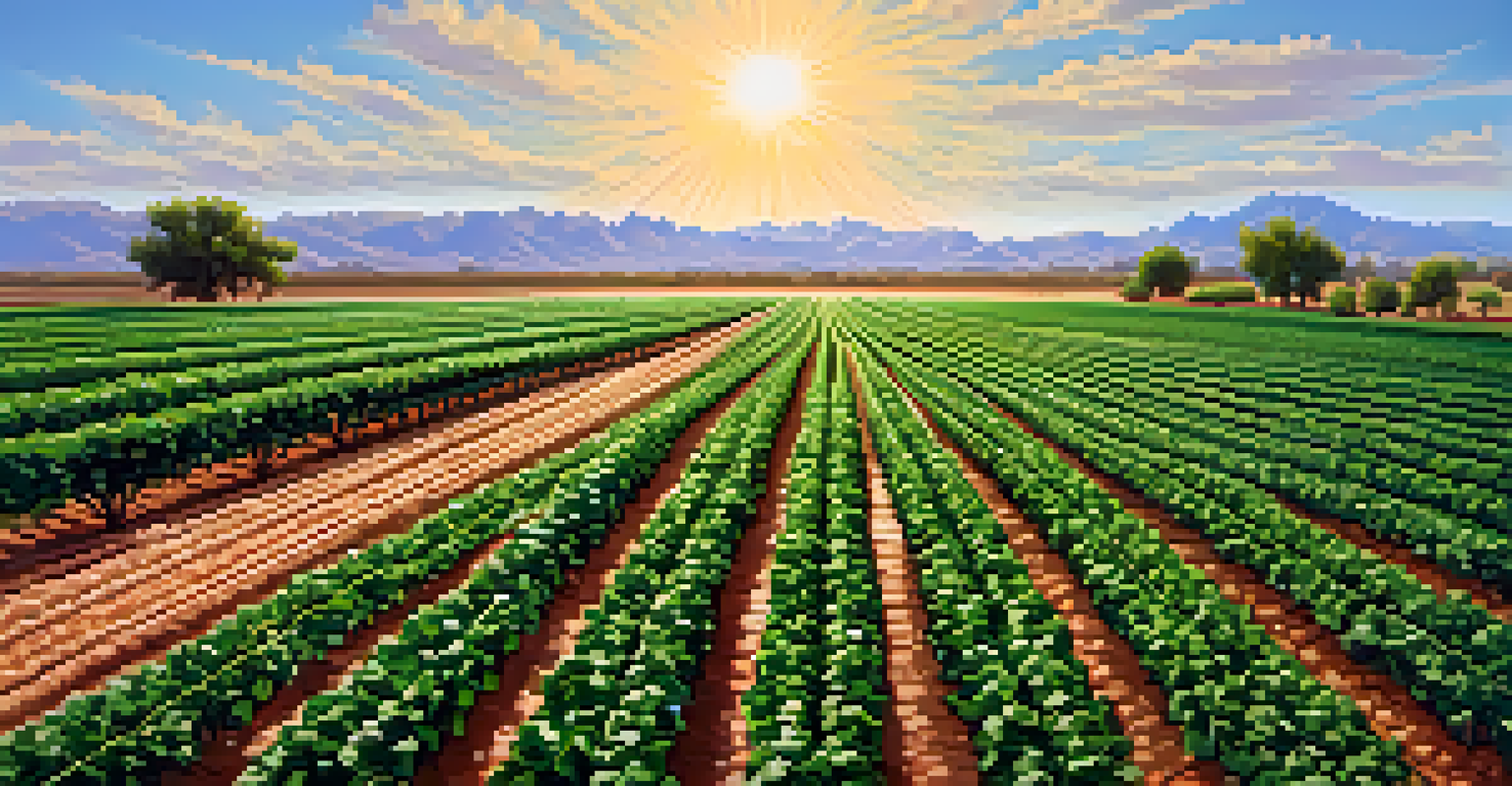Water Scarcity in Arizona: Current Challenges and Future Solutions

Understanding Water Scarcity in Arizona
Water scarcity in Arizona is a pressing issue that has evolved over time. With its arid climate and booming population, the demand for water exceeds the available supply. This imbalance not only affects residents but also impacts agriculture, industry, and the environment.
Water is the driving force of all nature.
The state's main water sources, including the Colorado River and groundwater, are dwindling. Over-reliance on these sources has led to significant challenges, as drought conditions and climate change exacerbate the situation. Understanding the extent of this crisis is crucial for future planning and sustainability.
Moreover, water scarcity is not just a number—it's a reality that affects daily life. From farmers struggling with crop irrigation to families facing higher water bills, the implications are widespread and urgent, calling for innovative solutions to address the challenges ahead.
Current Challenges Facing Arizona's Water Supply
One of the major challenges is the over-allocation of water resources. Historical agreements, like the Colorado River Compact, have set limits that now seem untenable given the current realities. As more states vie for their share, Arizona finds itself in a precarious position.

Additionally, population growth in urban areas has intensified the strain on water supplies. Cities like Phoenix and Tucson have seen explosive growth, leading to increased water consumption. This surge often outpaces the development of sustainable infrastructure, creating a gap in supply and demand.
Water Scarcity Affects Daily Life
Arizona's water scarcity impacts residents and industries, highlighting the urgent need for innovative solutions.
Lastly, environmental concerns cannot be overlooked. The depletion of rivers and aquifers not only threatens local ecosystems but also affects the quality of water available to residents. Balancing human needs with ecological preservation remains a significant hurdle in Arizona's water management strategy.
The Impact of Climate Change on Water Resources
Climate change is a major player in Arizona's water scarcity crisis. Rising temperatures have led to decreased snowpack in the mountains, which is crucial for replenishing river systems. This change not only reduces available water but also alters the timing of water flow.
We never know the worth of water till the well is dry.
Moreover, prolonged droughts are becoming more frequent and severe, putting additional pressure on already limited resources. As the climate continues to shift, the unpredictability of weather patterns makes water management increasingly complex.
This scenario highlights the importance of adaptive strategies. Understanding how to mitigate the effects of climate change on water supply is essential for Arizona's long-term sustainability. Without proactive measures, the state's water challenges could worsen significantly.
Agriculture's Role in Water Consumption
Agriculture is a cornerstone of Arizona's economy, but it is also a major consumer of water. About 70% of the state's water supply goes to agricultural use, primarily for crops like cotton and alfalfa. This heavy reliance raises questions about sustainability, especially in times of scarcity.
Farmers are increasingly challenged to find efficient irrigation methods. Traditional flood irrigation can waste precious resources, prompting a shift towards more innovative techniques like drip irrigation. These methods not only conserve water but also enhance crop yields, illustrating a path forward.
Population Growth Strains Resources
Rapid urban expansion in cities like Phoenix intensifies the demand for water, outpacing sustainable infrastructure development.
However, transitioning to more sustainable practices requires investment and education. Partnerships between government agencies and farmers can facilitate this change, ensuring that agriculture continues to thrive while minimizing its water footprint.
Urban Water Management Strategies
Urban areas in Arizona are implementing various strategies to manage water more efficiently. One approach is the promotion of water conservation programs that encourage residents to reduce consumption. Simple measures, like fixing leaks and using drought-resistant landscaping, can make a significant difference.
Additionally, cities are exploring alternative water sources, such as recycled wastewater. This approach not only provides a reliable supply but also helps alleviate pressure on freshwater resources. Innovative technologies are paving the way for a more sustainable urban water future.
Community engagement is critical in these efforts. By educating residents about the importance of water conservation and involving them in decision-making processes, cities can foster a culture of sustainability that benefits everyone.
Innovative Technologies for Water Conservation
Technological advancements are playing a crucial role in addressing water scarcity in Arizona. Innovations such as smart irrigation systems use sensors to optimize water usage, ensuring that plants receive just the right amount of moisture. This technology can significantly reduce waste and improve efficiency.
Moreover, water monitoring tools help track usage patterns, allowing for better management of resources. By understanding where and how water is consumed, cities and residents can identify areas for improvement and implement targeted strategies.
Climate Change Exacerbates Challenges
Rising temperatures and prolonged droughts due to climate change complicate Arizona's water management efforts.
Investing in research and development is essential for fostering these technologies. Collaboration between universities, government agencies, and private companies can drive innovation, leading to more effective solutions for water conservation in the state.
Community Engagement and Education Efforts
Community involvement is vital in combating water scarcity. Educational programs aimed at raising awareness about the importance of water conservation can empower residents to take action. Workshops, school programs, and public campaigns can inform people about practical ways to save water.
Local organizations often spearhead these initiatives, creating a sense of shared responsibility. When communities come together to tackle water issues, they not only enhance their resilience but also strengthen social bonds.

Additionally, fostering a culture of stewardship encourages individuals to view water as a precious resource. By instilling values of conservation and sustainability, Arizona can cultivate a more water-conscious society that prioritizes long-term solutions.